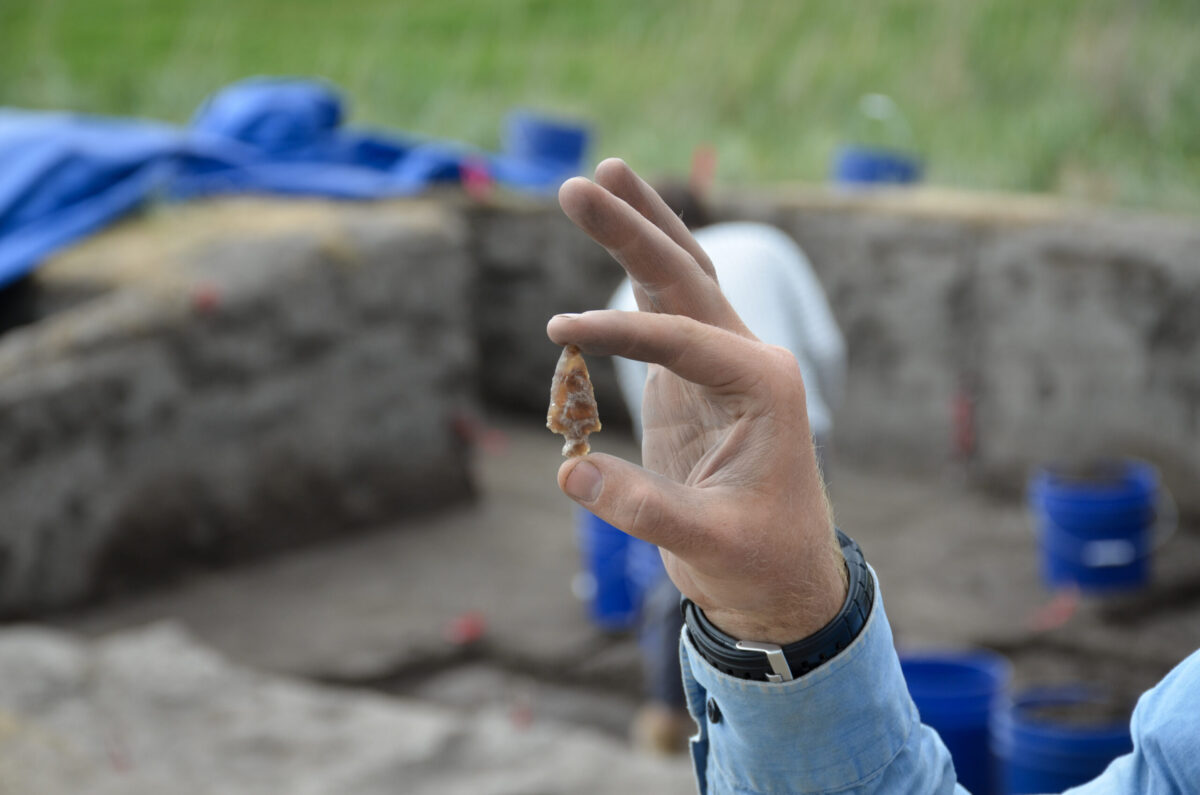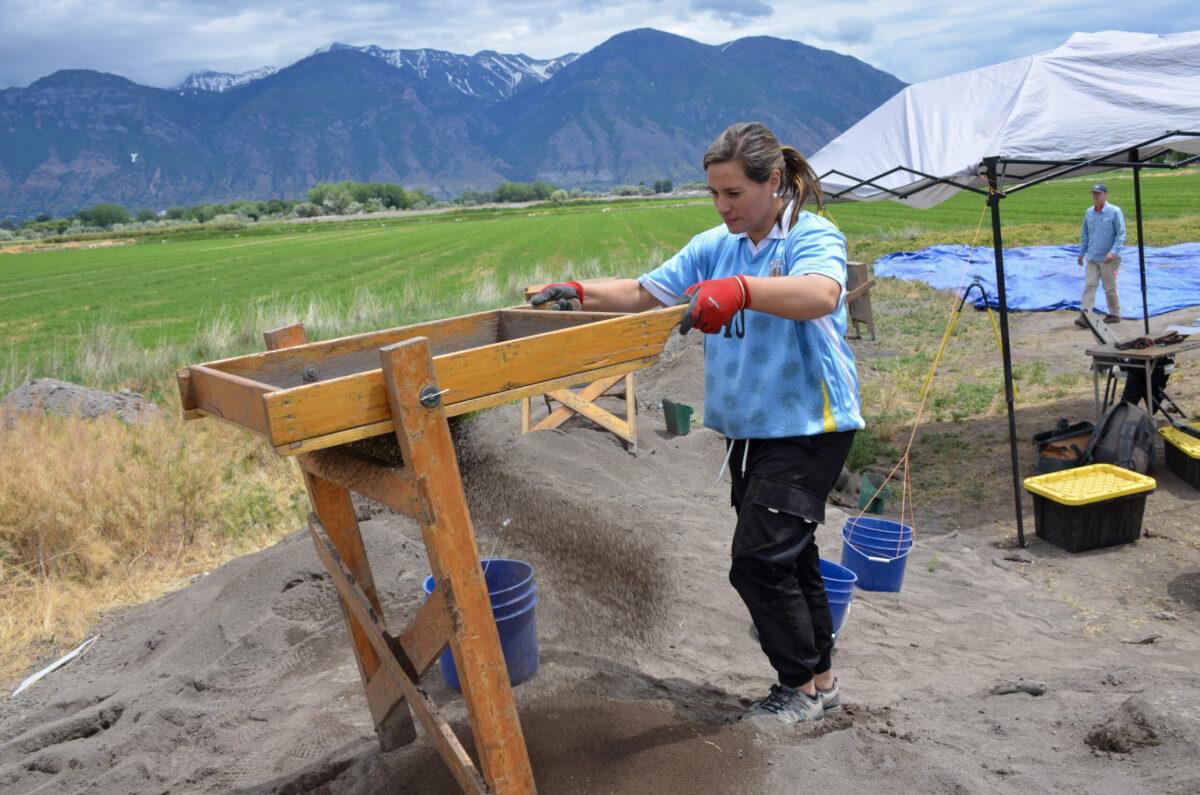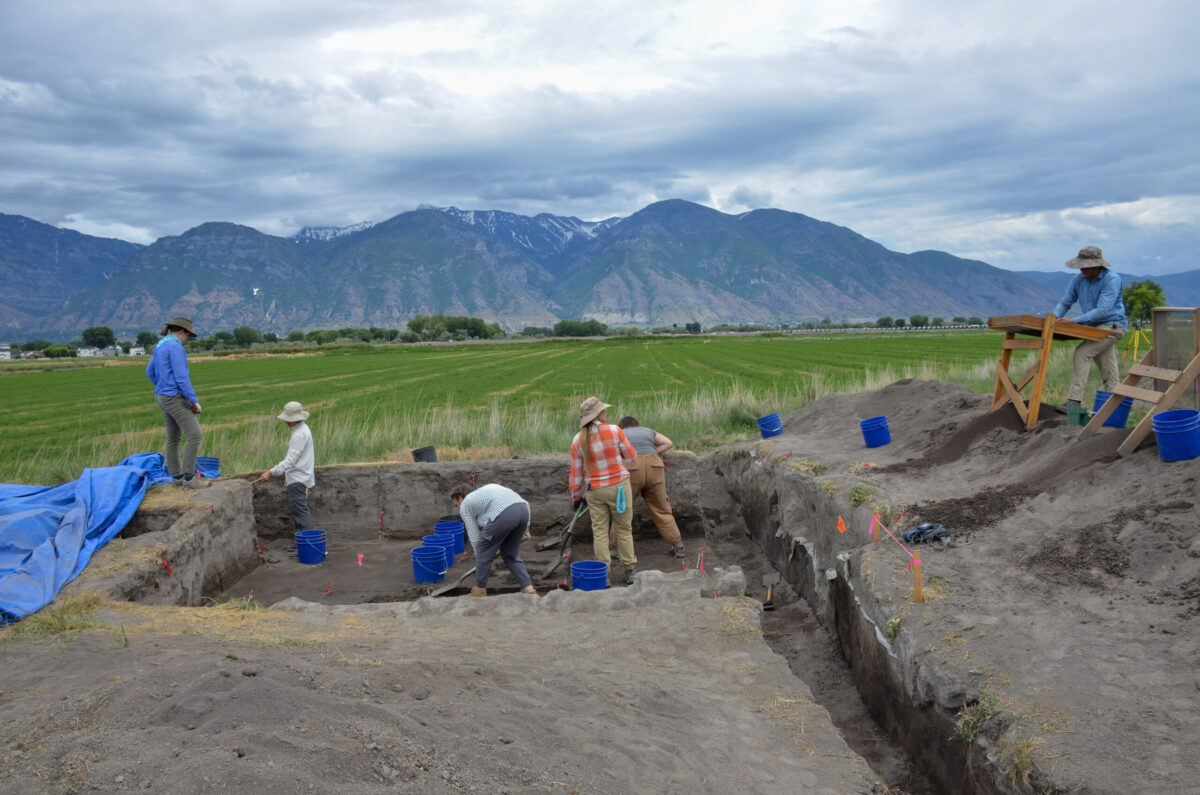BYU, Weber State students and faculty work together on Hinckley Mounds excavation
- Students and professors from Brigham Young University and Weber State University uncover a burned structure built over 1,000 years ago at an excavation site on Hinckley Mounds on Wednesday, June 14, 2023.
- Brigham Young University student Mason Lee holds an arrowhead he found in the Hinckley Mounds excavation site in Provo on Wednesday, June 14, 2023.
- Mike Searcy, right in plaid, works alongside his students to uncover Fremont artifacts at Hinckley Mounds in Provo on Wednesday, June 14, 2023.
- Brigham Young University student Carolina Corrales sifts through dirt collected in one of the excavation sites at Hinckley Mounds in Provo on Wednesday, June 14, 2023.
- Students and professors from Brigham Young University and Weber State University dig at an excavation site on Hinckley Mounds on Wednesday, June 14, 2023.
- Mike Searcy, right in plaid, works alongside his students to uncover Fremont artifacts at Hinckley Mounds in Provo on Wednesday, June 14, 2023.
“Doing archeology is like doing family history. You are telling the story of people who cannot tell their own story — cannot speak for themselves,” said Carolina Corrales, an undergraduate student at Brigham Young University.
Since May 2, undergraduate archeology students have been excavating the Hinckley Mounds located on Hinckley Farms near the Provo Airport. These mounds contain artifacts from the Fremont people, an indigenous group that lived throughout the southwest United States.
This year, though, the work is a joint effort between students and faculty from BYU and Weber State University. Leading the work this year is Mike Searcy, chair of BYU’s archeological program; Scott Ure, BYU associate professor; and David Yoder, associate professor of anthropology at Weber State.
BYU has been excavating the Hinckley Mounds since the 1930s. This is the first collaboration between the two at the Hinckley Mounds excavation, though they have worked together in southern Utah for the past two years.
BYU and WSU worked with John Hinckley Sr., property owner, to create this seven-week archeological field school for students. The program is required for all undergraduate students studying archeology at BYU and provides a hands-on learning approach. The students are on site every day for eight hours, working a full 40-hour week.
“Collaborating has been great for students because they get not just one professor, but they get experience with multiple professors, for networking, for learning all those different methods,” Yoder said.
Weber State does not have a graduate anthropology program, so this work helps students create connections to, potentially, enroll in BYU’s graduate program, Yoder said. This collaboration combines each of the professor’s specialties — ceramics for Searcy, Fremont figurines for Yoder and technology for Ure.
“We all just kind of bring a little something different and specialties to the table that allow the students to kind of share. And then not only that, we get to meet students that otherwise we wouldn’t get to know, and the bigger the crew the more dirt you move,” Searcy said.
Fremont is the name archeologists have given the Native American village which existed over 1,000 years ago. Little is known about the Fremont and there are no known descendants, but mounds indicate the coverage of a structure have been excavated to reveal artifacts. They have found structures, animal bones, spearheads, pottery and more indications of a thriving village that inhabited the entire Provo River Delta.
Before urban development, a plethora of these mounds could be found throughout the area from the Great Salt Lake to Nephi with many of these mounds on Hinckley Farm.
As city development continues, the few mounds left may become inaccessible or disappear completely. Archeologists want to preserve the land, but are unable to stop the city from developing over what is left.
“We receive a postcard every week in the mail (saying) we want to buy your property,” Hinckley told the Daily Herald. His daughter, Annie Robichaux, said they respond to the postcards by throwing them in the garbage and she plans to fight for the land to stay undeveloped.
“I’m just not afraid to fight with the city. If they want a fight they’ve got one,” she said. “As long as BYU wants to come and dig, we would love to have them.”
BYU has an agreement with Hinckley Farm to excavate the mounds, and according to Corrales, the landowners visit the site daily to talk with the crew and learn about discoveries.
The Hinckley family purchased the farm in 1898 and has owned it since. Hinckley said his father, in the 1920s and 1930s, used to find arrowheads and other artifacts above the ground after a heavy rainstorm. Hinckley Sr. was awarded the 2021 Outstanding Achievement Award from Utah State History for his efforts to preserve the archaeology on his land.
The Hinckleys do not request payment for the usage of their land but are given free access to the Museum of Peoples and Cultures at BYU where the artifacts are kept.
At this site, students have uncovered remains dating from approximately 750 A.D. to 1200 A.D. This gap, Searcy explained, may mean the Fremont people left the land for generations before returning. Excavators have discovered home and garden preparations made by the Fremont to handle flooding.
“I think it’s demeaning to think of these people as less developed than the way we live today. Obviously they had different technologies, but they are just as knowledgeable if not more so about the landscape than we are today,” Searcy said.
On May 14, Ellie Martin and several other students were digging out a burnt structure under one of the mounds, finding only the floor and burnt support beams. The burned structure was one of several found with figurines and other similar items placed in the center together. Searcy and students believe this means the structure was purposefully burned.
Robichaux, occasionally helping with the excavation, turned over a metate, or grinding bowl, that had been turned upside down thousands of years ago. Underneath it, researchers found pollen that has since been sent out for sampling.
“Archaeology is a destructive science. What we do you can never get back, so that’s why we record everything. We take photographs of everything, we take notes and stuff, because that’s the way that things get preserved,” said James Hall, BYU student.
With no descendants of the Fremont people, there are no advocates or people to claim human remains found on the site. “That’s why we have to be super respectful because there’s not the Fremont culture, there isn’t somebody that can speak for them, and so in a way we are speaking for them,” Hall said.
When they find a burial, the team works to follow protocols under the Native American Graves Protection and Respiration Act. They would then contact the police and physical anthropologists who would have a consultation with the tribe to try to identify affiliation. The current team has not found a burial site and one has not been found for several years.
Searcy said any geographically local tribe can claim affiliation, and at times the Hopi tribe located in northeastern Arizona has, but there have not been any Utah tribes to claim the Fremont.
Doing this excavation develops respect for the way the Fremont lived, Searcy said. They show their respect by remembering that artifacts belonged to real people — people who lived in what is now Utah and Utah County.
“In general, it is just kind of a reverence for how they live that I think keeps us and keeps the students realizing, you know, this stuff is important,” Searcy said. “We know that indigenous people, especially in the form of oral history, those are histories. They’re just not written as Western societies write things down.”
Doing this helps remove misconceptions that European settlers, or Latter-day Saint pioneers, were the first to live in Utah Valley, he said.












